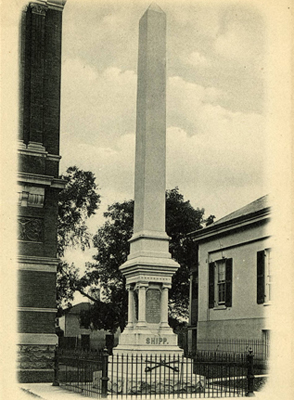
William Ewen Shipp Monument, Charlotte
This Winnsboro granite obelisk was installed to commemorate the bravery of William Ewen Shipp, an officer from Charlotte who was killed in the Spanish-American War. It remains one of the few monuments to heroes of that war in the area.
The first tier of the base of the monument looks unfinished, as the surface is rough and jagged. The tier above that has a cross of cavalry sabers with the number "10" in the middle. Atop the next tier is the base of the shaft, the bottom of which has Shipp's name inscribed. Above that are four columns, with a piece of granite placed between the front to hold the inscription, while the back is hollow. The shaft continues straight upwards and ends in a pyramid shape.
Images: Contemporary photographs courtesy of Jane Johnson (taken on May 20, 2014):
Standing tall and proud |
Close-up view |
Left side with an olive branch
Facing South Mint Street: AMONGST A GROVE / THE VERY STRAIGHTEST PLANT / WILLIAM EWEN SHIPP / FIRST LIEUTENANT / TENTH CAVALRY / U.S. ARMY / BORN AUGUST 2, 1861 / KILLED AT SAN JUAN / BATTLE OF SANTIAGO / JULY 1, 1898 / SHIPP / 10
Federal Courthouse in Charlotte, North Carolina
May 20, 1902
35.228760 , -80.846790
View in Geobrowse
Powell, William . "Shipp, William (Willie) Ewen," NCpedia.org (accessed August 23, 2014) Link
"A Memorial to Shipp," The News and Observer (Raleigh, NC), August 24, 1898, 4 Link
"Charlotte Celebrates - Unveiling of Stately Shaft to Late William Ewen Shipp the Feature of an Eventful Day," The Charlotte News, (Charlotte, NC), May 20, 1902, 1.
"Shipp Monument. Bill Introduced In Congress Yesterday," The Charlotte News, (Charlotte, NC), February 21, 1902, 5.
"Shipp Monument. Will Be Unveiled May 20 of Next Year," The Charlotte News, (Charlotte, NC), November 30, 1901, 1.
Charlotte, N.C. The Industrial Centre of the New South, in North Carolina Postcard Collection (P052), North Carolina Collection Photographic Archives, Wilson Library, UNC-Chapel Hill Link
National Park Service. U.S. Department of the Interior. National Register of Historic Places Program. "Nomination Form for Charles R. Jonas Federal Building," (accessed May 20, 2020) Link
Yes
Winnsboro granite
The monument was paid for by donations from North Carolina schoolchildren.
The monument dedication was incorporated into the city's May 20th celebrations of the Mecklenburg Declaration of Independence. The military led a procession of 5,000 people from city hall to the post office, where the monument was unveiled by Shipp's two sons. The ceremony opened with a band and prayer, after which Colonel John Peyre Thomas delivered a speech.
William Ewen Shipp lived in Charlotte during part of his adolescence and into adulthood. He was killed at San Juan Hill during the Battle of Santiago, dying what was deemed a heroic death under the U.S. flag.
The monument is located in the back corner of the U.S. District Court Clerk grounds near the corner of South Mint Street and West Fourth Street.
The monument was first located between the Post Office and the Charlotte Mint, but was relocated after the mint was demolished and the Post Office was expanded in 1934.
This Vintage Postcard shows the former location between the Post Office and the Charlotte Mint.
In February of 1902, a bill regarding the location of the monument was introduced to Congress. It passed in the House and a joint resolution of the Senate granted approval for the monument's installation in Charlotte, North Carolina. Because the monument was to be erected at the Charlotte Mint, which was considered United States property, the approval of Congress was required.
 Know anything else about this monument that isn't mentioned here? If you have additional information on
this or any other monument in our collection fill out the form at the Contact Us link in the footer. Thank you.
Know anything else about this monument that isn't mentioned here? If you have additional information on
this or any other monument in our collection fill out the form at the Contact Us link in the footer. Thank you.

